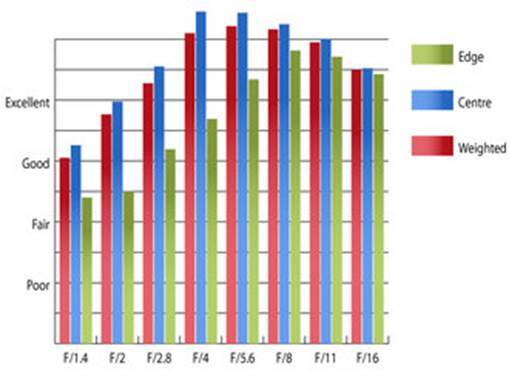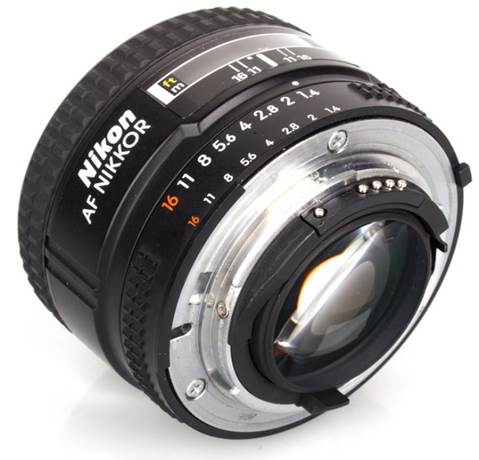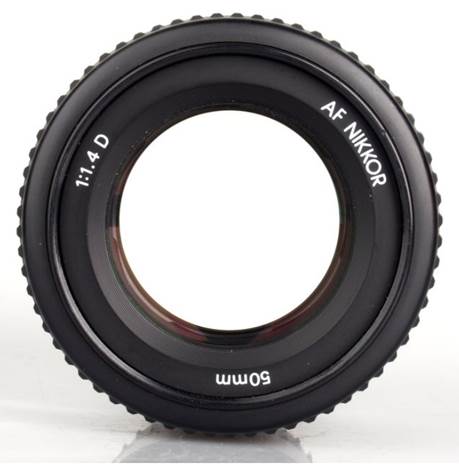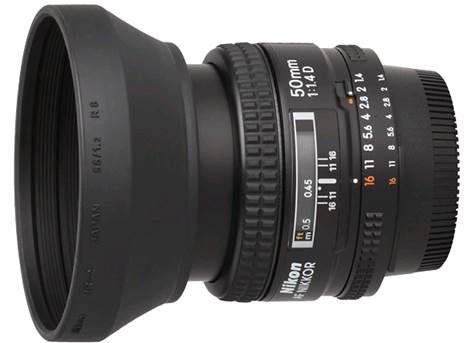This unique 50 mm lens is bought
after being popularly used, but it is still newly available with a reasonable discount for the newest version 50mm f/1.4G from
Nikon. The brand new product can be priced at $360 or $228
or even less if you bought a used.

Nikon
AF Nikkor 50mm f/1.4D
Performance
At the peaked aperture, an excellent status
has been recorded for the sharpness of the center of the frame, but that of the
frame edges falls a little bit behind to reach the good level. Stopping down
would help improving the performance of the frame with the exceptional
sharpness achieved in the center from f/2.8 or more, and the sharpness of the
frame peaks between the range of f/5.6 and f/8.

Chromatic
aberration evaluation
How to read our chart
The figures from the center of the frame at
different aperture are represented by the blue column and readings from the
edges are represented by the green column. Take the average of these two
figures we will come up with the red weighted column.
The scale on the left indicates the actual
image resolution. The higher the column is, the better the lens performs.
In this review, the lens has been tested on
a Nikon D700 which uses Imatest.
Chromatic aberrations levels are just a
little higher for edges of the frame at fast aperture, but when the lens stops
down under 0.5 pixel widths, the fringing decreases. The levels at wide
aperture can be seen in the image with high-contrast edges lying near the edges
of the frame.

Image’s
sharpness evaluation
How to read our chart
Chromatic aberration shows the inability to
focus on the sensor or blur all of the visible color of light at the same point
of the lens. Severe chromatic aberration indicates a noticeable fringing or a
halo effect surrounding the sharp edges within the picture. However, it can be
processed by software.
The Apochromatic lens has a unique glass
(aspheric, super-low dispersion,...) to minimize those problem above, so they
tends to have much higher price.
In this review, the lens was tested on the
Nikon D700 using Imatest
Because the lens is a typical product with
larger lens design, the falloff illumination levels towards corners of the
frames are very clear at fast aperture.
The powerfulness of the effect makes it
necessary for the images that captured by the stopped down lens to have
exposure compensated as the camera believes that the brightness is lower than
that in reality when metering wide open. At the aperture of f/4 or further, the
visually uniform illumination is achieved.
A typical characteristic of this old unique
lens is that at the maximum aperture, they tend to create a clearly visible
barrel distortion. This lens is not an exception, with Imatest detecting 1.95%
barreling. This level together straight lines towards the frame’s edges will be
easily noticeable in the picture. Fortunately, the pattern is distorted
uniformly across the frame, so the adjusting process would become easier to
apply to the photo editor software afterwards.
There is no sophisticating nano-crystal
coating that covers the lens, which leads to the reduction of the contrast when
shooting under the light with wide aperture and the flare would become a big
problem under the intense light condition.
Features and handling
The old lens version’s design from Nikon is
relatively more compact than their latter ones and this lens is not an
exception. Its diameter is 64.5mm and its length is 42.5mm. It is also just
230g in weight, which creates a compact and light combination with the Nikon
D700 which is chosen to conduct the test. Generally speaking, this lens looks
very good with the solid black plastics for the lens barrel and metal for the
lens mount. However, the brittle plastic made aperture ring and the small lug
show that the lens would be broken off easily if it is set to its smallest
aperture for auto operation and is abused.

The
lens’s front side
Because the lens belongs to the old ‘D’
version, the autofocus process is improved by the camera via a screw which
locates on the lens mount. This means the Nikon body will not automatically
focus when using with this lens if there is no motor inside the camera body.
The autofocus speed is quite fast, especially when compared to the ‘G’ version
of this lens. Unfortunately, sometimes is it not really precise, which leads to
the result of the disable to focus fully when shooting at wide apertures
because the lens zips moves quickly across the focus point. The focusing motor
must be removed from the lens in order for the manual control to be applied.
The narrow rubber focus ring does not always break in time, so it may cause the
focus process to be more complicated. Another positive noticeable point is that
because this lens has an aperture adjusting ring, it can be combined with the
old SLR camera which is compatible with the manual focus lenses.

The
focus ring
The closest focus distance is 45cm, and is
conducted by moving every glass backward and forward in the lens. This does not
happen to the 52mm filter ring as it does not rotate, which makes this lens an
ideal lens to use with polarized and graduated filters. There is not hood or
case coming with this lens. The accessories are also similarly solid as the
lens’s design with the front and back caps accompanied.
Sample pictures

Sample
pictures
Value
This old unique
lens costs $360 for a brand new one and %225 or less for a used one. Although
this lens is not very stylish and elegant for the design of a contemporary
camera, it is still capable of creating magnificent pictures and it is still
wonderful to buy a used one.
Nikon’s latest
AF-S 50mm f/1.4G has the price of $405 or so, and features the silent focusing
and allows applying the focus adjustments any time.
Sigma also
manufactures a 50mm f/1.4 lens, which also features the silent focus with
full-time override instruction. However, their 50 mm model offers a very high
price which is about $525.
If the maximum
aperture of f/1.4 is not necessary, Nikon’s 50mm f/1.8G model features the
silent focusing with the full time manual override but its price is just about
$225. The old ‘D’ version of Nikon’s f/1.8 50mm can also a good selection as it
just costs about $150 or the used one just costs $112.5.
Evaluation
Despite having a
design that dates back a couple of decades, this lens is still more than
capable of delivering excellent quality images. However it will pay dividends
to take the quirks of this optic into account to get the best results.
If you want to
have a fast f/1.4 maximum aperture and still want to save your budget, when
both of these things are important, the old f/1.4D 50mm is still an attractive
selection for buying used. For the purpose of saving about $45, if you decide
to buy a new one then an updated version lens would make more sense.
Although its
design is just like a couple of decades ago, this lens is more than just
creating magnificent pictures. However, it will pay dividends to compensate for
the disable of this optic lens to achieve the best results.

Although its design is just like a couple of decades
ago, this lens is more than just creating magnificent pictures.
Advantages
·
Good sharpness at the
center of the frame
·
Outstanding sharpness
when stopping down
·
Still have good value
if buying used
·
The build-quality is
solid enough
Disadvantages
·
Focusing by screw
·
The view angle is not
favorable at f/1.4
·
Inelegant design
compared to more contemporary lens
·
Specification
Technical specs
|
General
·
Lens mounts: Nikon
AF-S G
Lens
·
Focal Length: 50mm
·
Angle of View: 0-46°
·
Max aperture: f/1.4
·
Min Aperture: f/16
·
Filter Size: 58mm
Focusing
·
Min Focus: 45cm
·
Stabilized: no
Construction
·
Blades: 9
·
Elements: 8
·
Groups: 7
Dimension
·
Weight: 280g
·
Height: 54.2mm
|